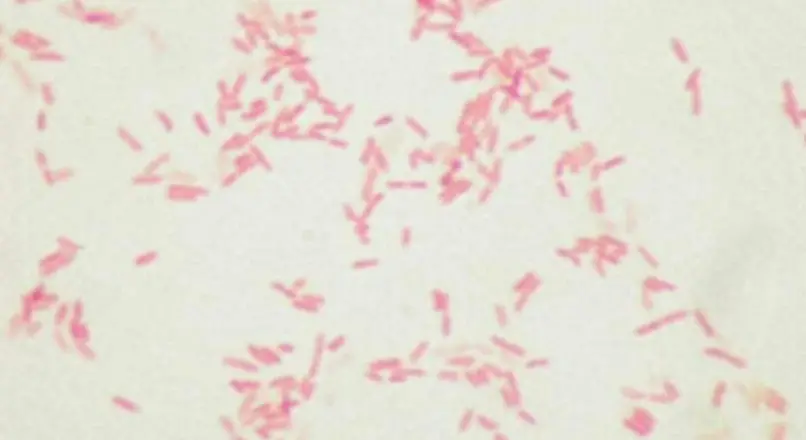
Stenotrophomonas maltophilia
Stenotrophomonas maltophilia is a multiple antibiotics resistant gram negative bacillus isolated from water and other environmental sources. It is an opportunistic pathogen with high morbidity and high mortality rate among hospitalised patients. It mostly causes diseases in hospitalised and immunocompromised patients. Stenotrophomonas maltophilia is an important causing nosocomial pathogen.
History
Stenotrophomonas maltophilia was named different in different times. In 1943 it was firstly found in pleural effusion and it was named as Bacterium bookeri. Then it was placed with pseudomonas named as Pseudomonas maltophilia in 1961. In the year 1983, it was moved to Xanthomonas but after 10 years it was placed in its own Genus Stenotrophomonas in 1983 and was named as Stenotrophomonas maltophilia.
Taxonomy
Stenotrophomonas maltophilia is a nosocomial pathogen classified as:
| Classification of Stenotrophomonas maltophilia | |
| Kingdom | Monera |
| Phylum | Proteobacteria |
| Class | Gammaproteobacteria |
| Order | Xanthomonadales |
| Family | Xanthomonadaceae |
| Genus | Stenotrophomonas |
| Specie | S. Maltophilia |
| Binomial Name Stenotrophomonas maltophilia | |
Microbiology
Stenotrophomonas maltophilia is a gram negative bacillus. Its size ranges from 0.7 to 1.8 µm in length and 0.4 to 0.7 µm in width. It is slightly smaller than other species of the Genus Stenotrophomonas. It is obligate aerobe capable of growing on blood agar and MacConkey agar.
It has polar flagella and is motile. It produces pigmented colonies on MacConkey agar. It is catalase positive and oxidase negative bacterium which helps it to differentiate from other organisms of its group. It has positive extracellular DNAse activity. It is capable of growing between 5°C to 40°C.
Diseases
Bacteraemia:
Stenotrophomonas maltophilia causes bacteraemia which have severe underlying conditions such as neutropenia and immunosuppression. Mostly it is due to infected catheter. Combination of antibiotics is prescribed for treatment of bacteraemia. Myelodysplastic syndrome (type of WBCs caner) is also seen.
Pulmonary infection:
Respiratory infection is mostly caused in the patients having mechanical ventilation or in the patients having malignancy. Pulmonary infections are mostly due to the colonisation of bacteria in the respiratory tract. Cystic fibrosis is also due to Stenotrophomonas maltophilia infection. Among all cystic fibrosis patients 10% are colonised with Stenotrophomonas maltophilia.
Endocarditis:
The endocarditis of Stenotrophomonas maltophilia occurs in intravenous drug abusers. Along with endocarditis, many complications such as abscess of valve ring and emboli can also happen.
Meningitis:
Meningitis, the influence of meninges is also happened due to Stenotrophomonas maltophilia. It mostly occurs in infants and also occurs as neurosurgical complications. It is very fetal condition only very few recoveries are reported.
Ocular infections:
Ocular infections such as keratitis and conjunctivitis and endopthalmitis can occur. Mostly occur infections occur as post-ocular surgery infections whereas keratitis can also be due to wearing infected contact lenses.
Peritonitis:
Stenotrophomonas maltophilia as a complication of chronic peritonial dialysis cause peritonitis. Combination of antibiotics and removal of the catheter is recommended to cure the disease.
Skin and soft tissue infections:
Stenotrophomonas maltophilia is also involved in causing skin and soft tissues infections in the person having wounds contaminated with soil or farm related machinery related accidents. Soft tissue infection can also happen in systematic Stenotrophomonas maltophilia infections. Cellulitis, mucus membrane ulceration, necrotizing gingivitis and subcutaneous nodules can occur.
Transmission
Stenotrophomonas maltophilia is present usually in the environment. It is a pathogen of low virulence but can be more virulent in immunocompromised people. It usually colonise hospital fluids and plastic apparatus used. It can also colonise patients secretions such as urine, sputum, wound exudats and respiratory secretions. It usually transmits through the exchange of these body fluids either directly or by using contaminated hospital fluids or apparatus. Stenotrophomonas maltophilia need to bypass normal host defence mechanism for causing disease in a human.
Pathology
Stenotrophomonas maltophilia has the ability to colonoze the humid plastic surfaces such as endotracheal tubes, endoscope and catheters. It can also colonize respiratory surfaces. Flagella and fimbrial adhesion help in this colonisation. It can also form biofilms. Lipopolysaccharides prevent it from compliment mediated killing. Lipid A causes the inflammation of the airway. Stenotrophomonas maltophilia also produces extracellular enzymes like DNAse, lipase, RNAse, Hemolysin and elastase which help in its pathogenicity.
Signs and Symptoms
The symptoms and signs are dependent on the body part infected with Stenotrophomonas maltophilia. Most commonly infected parts are lungs and blood.
- Patients whose lungs are infected with Stenotrophomonas maltophilia show the signs and symptoms similar to other bacterial pneumoniae including cough, fever, chest pain and shortness of breath.
- Bacteraemia patients have signs and symptoms like low blood pressure, pain in abdomen, nausea, vomiting, diarrhoea and rapid heart rate.
- Less common are the patients having infections of other body parts like endocarditis, peritonitis meningitis, urinary tract, eyes, skin and soft tissue infections. The signs and symptoms of these infections are similar to other bacterial infections of the same site.
Further complications
Immunocompromised persons can develop serious complications associated with Stenotrophomonas maltophilia. It is a mild pathogenic in normal persons. Complications associated with Stenotrophomonas maltophilia infection are:
- Bacteraemia is a serious complication which is associated to Stenotrophomonas maltophilia. It causes a high rate of failure in treatment which results even in deaths.
- Neutropenia is also seen which last more than 10 days.
- Stenotrophomonas maltophilia infection can also result in bacterial pneumonia, severe thrombocytopenia, shock syndrome and delay in having an appropriate treatment therapy.
- Immunocompromised Patients can also develop Stenotrophomonas maltophilia pneumonia which results in pulmonary hemorrhages and necrosis of tissues at the time of diagnosis.
Risk factors
Following are the risk factors associated with infections of Stenotrophomonas maltophilia;
- The major risk factor contributing to infection caused by Stenotrophomonas maltophilia is compromised immunity. Persons having any disease resulting in less immunity are more prone to have Stenotrophomonas infection.
- The disease is also associated with hospital settings. Persons can get Stenotrophomonas infection from hospitals too as it’s a nosocomial infection causing bacteria. The contact with infected body or hospital fluids is a major source of having a Stenotrophomonas maltophilia infection.
- Prophylaxis with broad spectrum antibiotics also has a role in having S. maltophilia infection.
- Radiotherapy and cytotoxic chemotherapy for cancer treatment
- Severe neutropenia and severe mucositis are also the risk factors of Stenotrophomonas maltophilia infection.
Diagnosis
For diagnosis, the sample can be taken from sterile body sites such as blood, pleural fluid and cerebrospinal fluid as well as from non sterile sites such as sputum or wounds. After culturing it is identified by its growth, microscopy and biochemical profile.
- It gives pigmented growth on MacConkey agar.
- It is gram negative bacillus with polar flagella.
- Catalase positive and oxidase negative.
- Ferment all sugars except rhamnose and mannitol.
- Molecular methods can also be used for the diagnosis of Stenotrophomonas maltophilia.
- Presence of Stenotrophomonas maltophilia in sterile fluid samples indicates its infection whereas from non-sterile sites represents its colonization only.
Treatment
Stenotrophomonas maltophilia is present in environment so it is tough to eradicate it. It has broad-spectrum antibiotics resistance including resistance to all carbapenems. Before the prescription of any antibiotic treatment antibiotics susceptibility test should be done. Agar dilution method should be used instead of disc diffusion method which doesn’t give reliable results. Many strains of Stenotrophomonas maltophilia are sensitive to ticaracillin, piperacillin and ceftazidime. Polymyxin B is also seen effective in its in vitro use. The use of a combination of antibiotics is also done to treat Stenotrophomonas infections such as trimethoprim and sulfamethoxazole combination is seen effective.
Prevention
The source of infection of Stenotrophomonas maltophilia is usually uncertain as it is present in the environment. If its source is hospital then these strains differ usually from the strains present in that environment. Surveillance of water should be done to check its contamination. If any contaminated medical or environmental source is found it needs to be removed. Unnecessary use of antibiotics is causing resistance against antibiotics which need to be stopped. Currently, there is no available vaccine for this bacterium.


